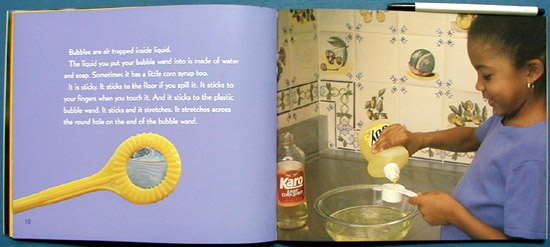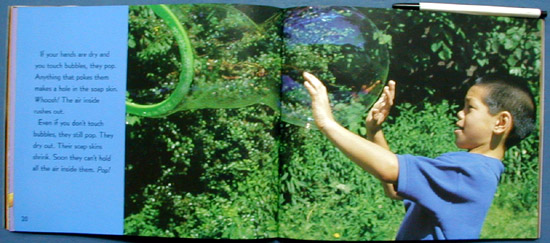|
|
|
|
 |
 이전 | 이전 |  목록 | 다음 목록 | 다음 |
|
|

상세그림 1 |

상세그림 2 |
|
확대 이미지 : 상세그림 1

|
확대 이미지 : 상세그림 2

|
[ 책 소개 ]
Harper Collins의 Let's-Read-and-Find-Out Science시리즈는 과학의 기본개념을 알기 쉽게 소개하며 어린 아이들의 과학, 기술, 자연에 관한 다양한 호기심과 궁금증을 해결해 줄 수 있는 우수한 어린이 과학도서입니다.
비누방울은 왜 항상 동그랗고 터지는지, 네모난 비누방울은 만들 수 없는지, 큰 비누방울과 많은 비누방울 만들기 등 어린 아이들이 가장 좋아하는 놀이감중 하나인 비누방울 속에 숨겨진 재미있는 과학이야기를 들려줍니다.
[ 서지 정보 ]
Edition: Paperback: 34 pages
ISBN-10: 0064452085
ISBN-13: 978-0064452083
책 크기: 25cm x 20cm
[ 영문 서평 ]
Children's Literature
What are bubbles made of? Why are they round? Why do they always pop? Investigate the basic science of bubbles with an author who has a degree in chemistry. Vivid photographs and clear, simple text introduce young children to science and help answer questions about one of childhood's greatest joys. Bubbles are simply air trapped inside liquid. They are round because the air inside pushes out evenly against the liquid skin. Bubbles eventually pop because their liquid skin dries out and shrinks, making them unable to hold all the air inside. After learning about bubbles and seeing so many pictures of colorfully captured bubbles, it may be the perfect time to make your own. To do so, follow the bubble solution recipe at the back of the book. You probably have the ingredients in your cupboard. Then you can try some of the experiments that follow. For example, if you make a square shaped wand, will you get square shaped bubbles? All young scientists should give it a try. Part of the "Let's Read-and-Find-out About Science" series.
School Library Journal
Bubbles here, bubbles there, bubbles, bubbles, bubbles everywhere-big ones, small ones, single ones, or in a stream. Some float gently, while some pop immediately. No matter what they are made of or how or where they are produced, they are always round, never square. A simple, accurate text that is also fun to read explains these facts. Delightful color photographs of charming children making bubbles and of bubbles floating freely reinforce and extend the text. Children will want to participate themselves to test the data. The book includes a page of experiments and a recipe for making a solution (which may need some adult help to prepare). This is science learning at its best.
Kirkus Reviews
What makes a bubble? Why does it pop? What makes it round? These and a dozen other questions are clearly explained in a brief, readable text in this "Let's-Read-And-Find-Out" Stage 1 science title. Bradley (Weaver's Daughter, 2000, etc.), a chemist and a mother of two enthusiastic bubble blowers, is right on target with questions and answers. Explaining that the air inside the soapy skin of a bubble doesn't push out more in one place or another, she effectively offers a mini-physics lesson. Moving on to demonstrate other liquids, she explains why some bubbles pop easier than others. Clear color photographs help to demonstrate each idea, using a racially mixed group of boys and girls blowing, popping, and examining big and little bubbles in various liquids. The author concludes with a recipe for making bubble solution and additional experiments with bubbles. Young readers (and their parents) will have a good time learning new science thanks to this playful offering.
|
| * 최근 이 작품을 구입하신 분들의 다른 선택 |
Super Marsupials
Let's-Read-and-Find-Out Science, Level 1, 슈퍼바이 |
Charlotte's Web: Wilbur's Prize
An I Can Read Book, 2단계, 슈퍼바이 |
Fancy Nancy: Time for Puppy School
An I Can Read Book, 1단계 |
Oceans
Seymore Simon과 스미소니언 박물관의 과학사진책 시리즈, 슈퍼바이 |
|
| |
|
|< << [1] [2] [3] [4] [5] [6] [7] [8] [9] [10] >> >|
|
|
|